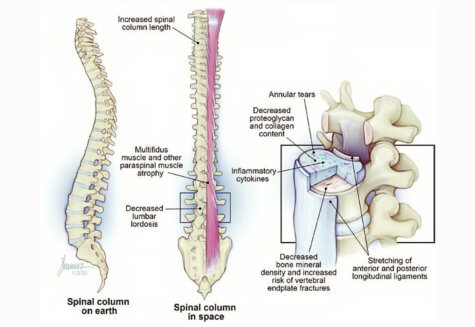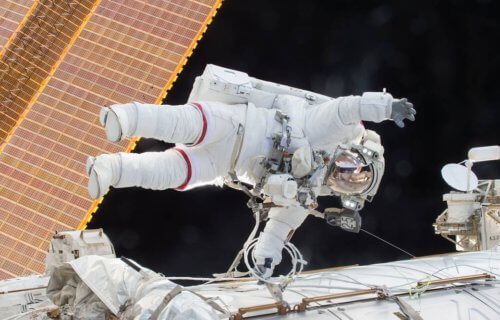
BALTIMORE, Md. — Astronauts can grow up to three inches during space missions. Unfortunately, life in zero gravity can also leave them with chronic back pain, a new study reveals. Researchers at Johns Hopkins University say learning how to help space travelers may also lead to new back pain remedies for people here on Earth.
Study authors say weightlessness allows an astronaut’s spine to straighten, making them “grow.” When they’re back on Earth however, gravity crunches their spine which can leave them in debilitating pain. The spinal curvature, an S-shaped bend that helps the spine resist gravity, stays flexible and absorbs weight and impact. However, it flattens out in space and spine MRI scans show astronauts have a smaller curve in their spine upon their return.

“If reduced gravity allows this curvature to straighten,” says Dr. Radostin Penchev, a resident physician at Johns Hopkins, in a university release. “This not only could be a cause of acute pain in astronauts, but also could affect the stability of their spine when they return to Earth.”
How do astronauts try to prevent back issues?
The researchers say 80 percent of space travelers developed back pain at some point after touching back down on Earth. Most of the time, it disappears on its own, but astronauts are at higher risk of sciatica — a type of back pain that can radiate into your legs.
The research team, whose analysis appears in the journal Anesthesiology, says the stress and vibration of riding in a rocket and the changes to astronauts’ diets while in space could also be causing pain. Astronauts have often hit the gym in a bid to stop this pain by engaging in resistance exercises, such as isometrics, squats, lunges, and bench pressing. These are typically mainstays of back pain prevention.
Space stations now have exercise machines and other resistance training tools on board to help with this. Resistance suits can alleviate back pain in 85 percent of sufferers when combined with regular exercise. They help activate muscle groups from the shoulders to hips, but some say they are uncomfortable as it feels like they have a rubber band across their upper body.
Massages, vitamin D and calorie supplements, electrical muscle stimulation, and negative pressure devices can also help if combined with exercise, the researchers state.
“Insight into back pain in space travelers may provide usable information to treat back pain in other populations,” Professor Steven Cohen adds.
Could special space suits fix back pain?
With a growing number of people venturing into space, the team predicts that more people getting this opportunity will develop chronic back pain.
“Science fiction has popularized the spinning space station that uses centrifugal force to mimic gravity,” Dr. Penchev says.
Penchev notes that a more realistic, and perhaps better alternative, will be the development of specialized suits which provide spinal resistance similar to the effect Earth’s gravity creates. Just over half of astronauts (52%) end up with some form of back pain two to five days after returning to Earth, according to a 2012 study analyzing 722 space flights.
The condition, dubbed “space adaptation back pain,” can make it harder to complete daily tasks although most cases are mild. Astronauts are more than four times more likely to herniate a disc, NASA found in 2010. The risk is even higher in the first year after space travelers return to Earth.
A separate study of military helicopter pilots and crew from the University of Innsbruck in Austria found almost half of those who experienced fluctuating gravity reported lower back pain. Pilots were almost three times as likely to develop lower back disc herniation, an injury to soft connective cushioning in the spine.
South West News Service writer Gwyn Wright contributed to this report.
